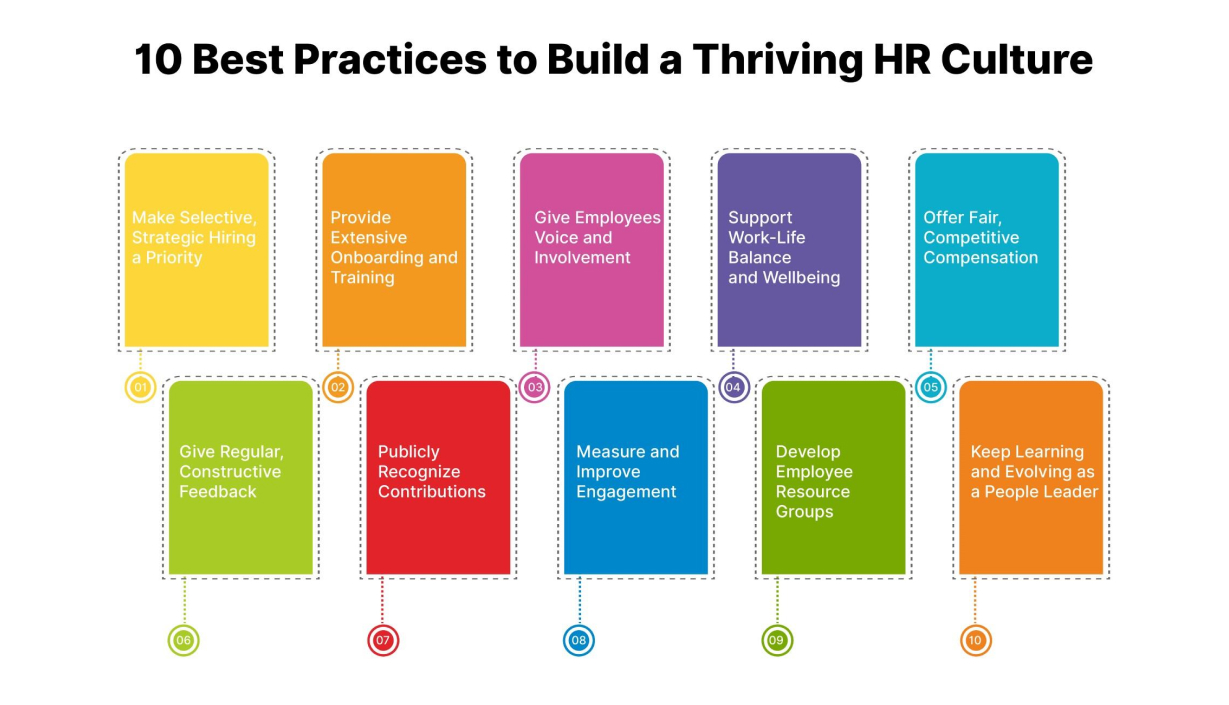
A people-centric organization is one that puts its employees first. From policies to culture to operations, everything revolves around supporting and empowering people. Research shows that companies with strong people-centric cultures have up to 30% higher productivity and enjoy much lower turnover.
As an HR professional, you play a pivotal role in cultivating this type of supportive environment. By implementing key human resources best practices around hiring, development, engagement and more, you can transform your organization into one where both employees and the business thrive.
To build a thriving HR culture, here are 10 essential best practices every organization should follow:
.
1. Make Selective, Strategic Hiring a Priority
Implementing a selective, strategic hiring process allows you to carefully choose candidates that will thrive in your people-centric culture. Develop a clear picture of both the hard and soft skills needed to excel in each role. Then, design targeted job listings that paint an appealing vision of your workplace and its values.
In interviews, ask questions that reveal cultural add just as much as qualifications. Look for hopefuls that are purpose-driven, growth-minded, compassionate and collaborative. Check references thoroughly to confirm candidates walk their talk. Moving slowly through recruitment may take more upfront effort but prevents expensive, morale-damaging turnover that results from poor fits. Invest time in finding the right hires who'll become engaged, loyal team players.
2. Provide Extensive Onboarding and Training
The best way to empower people is through extensive development opportunities. Go above and beyond bare minimum training by implementing in-depth onboarding processes coupled with robust, ongoing education. For onboarding, devote several weeks orienting new employees to give them strong foundations. Thoroughly cover company vision, cultural values, workplace tools and day-to-day expectations. Introduce them to mentors who can provide guidance beyond basic job tasks.
Also explain growth trajectories so they feel invested long-term. Later, offer ample training workshops, online courses, stretch assignments, mentoring relationships and other growth forums. Employees shouldn't just maintain skills but regularly expand them. Professional development demonstrates continual investment which boosts engagement, performance and retention.
3. Give Employees Voice and Involvement
Don't just say you value input - give people a genuine voice at every level. Institute open door policies, anonymous surveys and staff forums to collect transparent feedback. Generate two-way dialogue through skip-level meetings where managers and direct reports hold constructive discussions. Invite staff to participate in shaping policies around scheduling, benefits, wellness, etc. so they feel heard and involved.
Voice opportunities foster inclusion by breaking down hierarchy barriers and making people take ownership over their contributions. Empower task forces of frontline employees to research issues and present recommendations directly to leadership. Listening to those doing the work unearths invaluable insights. Encourage all employees to share ideas freely.
4. Support Work-Life Balance and Wellbeing
A people-centric workplace realizes employees have full lives outside work. Promote balance by allowing flexible remote work options and encouraging people to disconnect from email after hours or while on vacation. Discourage perpetually burnt out "hustle culture" attitudes that glorify excessive work hours. Instead, invest in wellbeing initiatives around financial planning, physical health, mental health, continuing education and more.
For instance, you might offer access to counselors, gym discounts or student loan assistance. Show employees their whole selves matter by supporting their pursuit of happiness both inside and outside the office. This attracts caring, loyal people who'll stick around for the long haul.
5. Offer Fair, Competitive Compensation
Employees trade valuable time and effort for fair pay that provides livelihood. Develop competitive compensation packages that benchmark against industry standards, reflecting different contribution levels. Associate higher pay rates with increased tenure, expanded duties and excellence performance. Update wages as roles evolve so people are always earning what their expanding capabilities warrant. Dangle carrots by offering profit sharing when organization-wide goals are met to spur teamwork.
Beyond pay rates, furnish in-demand benefits like ample time off, retirement savings matches, advancement opportunities and flexible work arrangements. Compelling compensation demonstrates the tremendous worth you place on people. It recognizes their essential contributions to success.
6. Give Regular, Constructive Feedback
It is critical for managers to have regular one-on-one meetings with each direct report to discuss performance and development. These sessions should occur at least monthly. The discussions should focus on reviewing goals, addressing what is going well and what needs improvement, removing roadblocks, and setting plans for growth.
Managers must approach performance discussions from a perspective of compassion, not criticism. The feedback should be kind yet constructive, focusing on specific behaviors and outcomes that need to change, rather than making personal attacks. Guidance should be given on tangible things the employee can do to improve their skills, processes, and results.
7. Publicly Recognize Contributions
When employees demonstrate behaviors aligned to the organization’s values, managers should praise these actions publicly. For example, if a team member goes above and beyond to satisfy a customer, exhibiting the value of client commitment, the manager should call out this win in a team meeting or newsletter. This reinforces actions and qualities the organization wants to champion.
Peer-to-peer appreciation programs enable employees to recognize each other for achievements big and small. These platforms make it easy to share shoutouts which get prominently displayed on the corporate intranet for all to see. Features like badges and leaderboards gamify praise. Public peer recognition boosts morale and connectivity.
8. Measure and Improve Engagement
It’s vital to regularly check the pulse of employees to understand their sentiments. Short monthly or quarterly surveys should ask targeted questions to assess factors like job satisfaction, manager effectiveness, alignment on strategy, and comfort raising concerns. The anonymity of these quick polls encourages candid feedback.
HR must carefully evaluate engagement survey findings to call out trends and drill down into problem areas. If a department shows declining scores, it warrants further exploration into why. Focus groups and manager feedback can uncover deeper root causes behind dissatisfaction.
Insights gained from engagement surveys and analysis should drive concrete action planning. If employees signal lack of growth opportunities, HR and managers should collaborate on career development initiatives. If scores indicate unclear decision-making, improved communication may be needed from leadership. Targeted improvements will continually optimize the employee experience.
9. Develop Employee Resource Groups
Employee Resource Groups (ERGs) bring together employees by specific identities, backgrounds, or interests to find community, camaraderie, and social support. These affinity groups connect individuals who often have common experiences outside of their day-to-day jobs. Covering categories like women, LGBTQ+ employees, veterans, working parents, or cultural heritages, ERGs provide safe spaces for sharing.
In addition to community-building, ERGs play an instrumental role in mentorship and advancement, especially for minority groups. More senior members will mentor younger employees to help them develop professionally. The groups provide leadership opportunities by managing their own programming and budgets. Members take on stretch assignments to influence D&I strategies.
10. Keep Learning and Evolving as a People Leader
Great leadership requires regularly developing new skills. Managers should have ongoing training in areas like conflict resolution, performance management, strategic planning, and communicating across differences. As priorities shift, leaders must commit time for learning. HR can provide resources, tools and mentors to promote continuous growth.
Managers should actively solicit suggestions from both employees and their own managers on how to improve, then integrate this feedback into goal-setting and development planning. Peers who attend the same company leadership training can also share constructive observations they observe. Proactive feedback-seeking strengthens self-awareness.
People-management capabilities depend on tuned emotional intelligence to foster trust, unity and integrity on teams. Self-reflection, empathy, self-care, and managing stress are skills that leaders must continually develop. Feedback from assessments measuring EQ dimensions can heighten growth in these critical areas over time.
Becoming a people-centric organization starts with implementing HR best practices that demonstrate employees matter most. Give staff greater voice, nurture their wellbeing, develop their abilities and reward their efforts. When people know they can thrive, perform their best and be valued for who they are, you cultivate an engaging, uplifting culture that fuels sustainable success.

CredBadge™ is a proprietary, secure, digital badging platform that provides for seamless authentication and verification of credentials across digital media worldwide.
CredBadge™ powered credentials ensure that professionals can showcase and verify their qualifications and credentials across all digital platforms, and at any time, across the planet.

Please enter the License Number/Unique Credential Code of the certificant. Results will be displayed if the person holds an active credential from TMI.